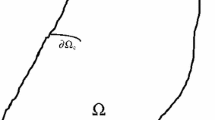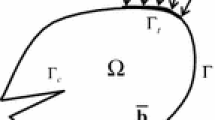Abstract
The conventional extended finite element method (XFEM) is enhanced in this paper to simulate dynamic crack branching, which is a top challenge issue in fracture mechanics and finite element method. XFEM uses the enriched shape functions with special characteristics to represent the discontinuity in computation field. In order to describe branched cracks, it is necessary to set up the additional enrichment. Here we have developed two kinds of branched elements, namely the “element crossed by two separated cracks” and “element embedded by a junction”. Another series of enriched degrees of freedom are introduced to seize the additional discontinuity in the elements. A shifted enrichment scheme is used to avoid the treatment of blending element. Correspondingly a new mass lumping method is developed for the branched elements based on the kinetic conservation. The derivation of the mass matrix of a four-node quadrilateral element which contains two strong discontinuities is specially presented. Then by choosing crack speed as the branching criterion, the branching process of a single mode I crack is simulated. The results including the branching angle and propagation routes are compared with that obtained by the conventionally used element deletion method.


















Similar content being viewed by others
References
Ravi-Chandar K, Knauss WG (1984) An experimental investigation into dynamic fracture-III. On steady-state crack propagation and crack branching. Int J Fract 26:141–154
Sharon E, Gross S, Fineberg J (1995) Local crack branching as a mechanism for instability in dynamic fracture. Phys Rev Lett 74:5096–5099. doi:10.1103/PhysRevLett.74.5096
Boudet JF, Ciliberto S, Steinberg V (1996) Dynamics of crack propagation in brittle materials. J Phys II France 6:1493–1516. doi:10.1051/jp2:1996144
Fliss S, Bhat HS, Dmowska R, Rice JR (2005) Fault branching and rupture directivity. J Geophys Res 110:B06312. doi:10.1029/2004jb003368
Bhat HS, Olives M, Dmowska R, Rice JR (2007) Role of fault branches in earthquake rupture dynamics. J Geophys Res 112:B11309. doi:10.1029/2007jb005027
Fineberg J, Sharon E (1999) Confirming the continuum theory of dynamic brittle fracture for fast cracks. Nature 397:333–335. doi:10.1038/16891
Yoffe EH (1951) The moving Griffith crack. Philos Mag 42:739–750. doi:10.1080/14786445108561302
Eshelby JD (1999) Energy relations and the energy-momentum tensor in continuum mechanics. Fundamental Contributions to the Continuum Theory of Evolving Phase Interfaces in Solids. 82–119. doi:10.1007/978-3-642-59938-5_5
Adda-bedia M (2005) Brittle fracture dynamics with arbitrary paths III. The branching instability under general loading. J Mech Phys Solids 53:227–248. doi:10.1016/j.jmps.2004.06.001
Martín T, Español P, Rubio MA (2005) Mechanisms for dynamic crack branching in brittle elastic solids: strain field kinematics and reflected surface waves. Phys Rev E 71:036202. doi:10.1103/PhysRevE.71.036202
Katzav E, Adda-Bedia M, Arias R (2007) Theory of dynamic crack branching in brittle materials. Int J Fract 143:245–271. doi:10.1007/s10704-007-9061-x
Zhou SJ, Lomdahl PS, Thomson R, Holian BL (1996) Dynamic crack processes via molecular dynamics. Phys Rev Lett 76:2318–2321. doi:10.1103/PhysRevLett.76.2318
Bolander JE Jr, Saito S (1998) Fracture analyses using spring networks with random geometry. Eng Fract Mech 61:569–591
Xu X-P, Needleman A (1994) Numerical simulations of fast crack growth in brittle solids. J Mech Phys Solids 42:1397–1434
Ha YD, Bobaru F (2010) Studies of dynamic crack propagation and crack branching with peridynamics. Int J Fract 162:229–244. doi:10.1007/s10704-010-9442-4
Rabczuk T, Song J-H, Belytschko T (2009) Simulations of instability in dynamic fracture by the cracking particles method. Eng. Fract. Mech. 76:730–741. doi:10.1016/j.engfracmech.2008.06.002
Henry H (2008) Study of the branching instability using a phase field model of inplane crack propagation. Europhys Lett 83:16004. doi:10.1209/0295-5075/83/16004
Borden MJ, Verhoosel CV, Scott MA, Hughes TJR, Landis CM (2012) A phase-field description of dynamic brittle fracture. Comput Methods Appl Mech Eng. 217–220:77–95. doi:10.1016/j.cma.2012.01.008
Belytschko T, Black T (1999) Elastic crack growth in finite elements with minimal remeshing. Int J Numer Methods Eng 45:601–620
Moës N, Dolbow J, Belytschko T (1999) A finite element method for crack growth without remeshing. Int J Numer Methods Eng 46:131–150
Song J-H, Areias PMA, Belytschko T (2006) A method for dynamic crack and shear band propagation with phantom nodes. Int J Numer Methods Eng 67:868–893. doi:10.1002/nme.1652
Duan QL, Song J-H, Menouillard T, Belytschko T (2009) Element-local level set method for three-dimensional dynamic crack growth. Int J Numer Methods Eng 80:1520–1543. doi:10.1002/nme.2665
Daux C, Moës N, Dolbow J, Sukumar N, Belytschko T (2000) Arbitrary branched and intersecting cracks with the extended finite element method. Int J Numer Methods Eng 48:1741–1760
Belytschko T, Chen H, Xu J, Zi G (2003) Dynamic crack propagation based on loss of hyperbolicity and a new discontinuous enrichment. Int J Numer Methods Eng 58:1873–1905. doi:10.1002/nme.941
Song J-H, Wang H, Belytschko T (2007) A comparative study on finite element methods for dynamic fracture. Comput Mech 42:239–250. doi:10.1007/s00466-007-0210-x
Song J-H, Belytschko T (2009) Cracking node method for dynamic fracture with finite elements. Int J Numer Methods Eng 77:360–385. doi:10.1002/nme.2415
Zhuang Z, Cheng BB (2011) Development of X-FEM methodology and study on mixed-mode crack propagation. Acta Mech Sin 27:406–415. doi:10.1007/s10409-011-0436-x
Zhuang Z, Cheng BB (2011) Equilibrium state of mode-I sub-interfacial crack growth in bi-materials. Int J Fract 170:27–36. doi:10.1007/s10704-011-9599-5
Stolarska M, Chopp DL, Moës N, Belytschko T (2001) Modelling crack growth by level sets in the extended finite element method. Int J Numer Methods Eng 51:943–960
Fries T-P, Belytschko T (2010) The extended/generalized finite element method: an overview of the method and its applications. Int J Numer Methods Eng 84:253–304. doi:10.1002/nme.2914
Zi G, Song J-H, Budyn E, Lee S-H, Belytschko T (2004) A method for growing multiple cracks without remeshing and its application to fatigue crack growth. Model Simul Mater Sci Eng 12:901–915. doi:10.1088/0965-0393/12/5/009
Menouillard T, Réthoré J, Combescure A, Bung H (2006) Efficient explicit time stepping for the eXtended finite element method (X-FEM). Int J Numer Methods Eng 68:911–939. doi:10.1002/nme.1718
Chinese Aeronautical Establishment (1981) Stress intensity factor handbook (in Chinese). Science press, Beijing
Freund LB (1990) Dynamic fracture mechanics. Cambridge monographs on mechanics and applied mathematics. Cambridge University Press, Cambridge
Sharon E, Fineberg J (1996) Microbranching instability and the dynamic fracture of brittle materials. Phys Rev B 54:7128–7139. doi:10.1103/PhysRevB.54.7128
Ramulu M, Kobayashi AS (1985) Mechanics of crack curving and branching—a dynamic fracture analysis. Int J Fract 27:187–201
Ravi-Chandar K (1998) Dynamic fracture of nominally brittle materials. Int J Fract 90:83–102
Acknowledgments
This work is supported by the National Natural Science Foundation of China under Grant No. 11372157 and The Special Research Grant for Doctor Discipline by Ministry of Education of China under Grant No. 20120002110075
Author information
Authors and Affiliations
Corresponding authors
Rights and permissions
About this article
Cite this article
Xu, D., Liu, Z., Liu, X. et al. Modeling of dynamic crack branching by enhanced extended finite element method. Comput Mech 54, 489–502 (2014). https://doi.org/10.1007/s00466-014-1001-9
Received:
Accepted:
Published:
Issue Date:
DOI: https://doi.org/10.1007/s00466-014-1001-9




